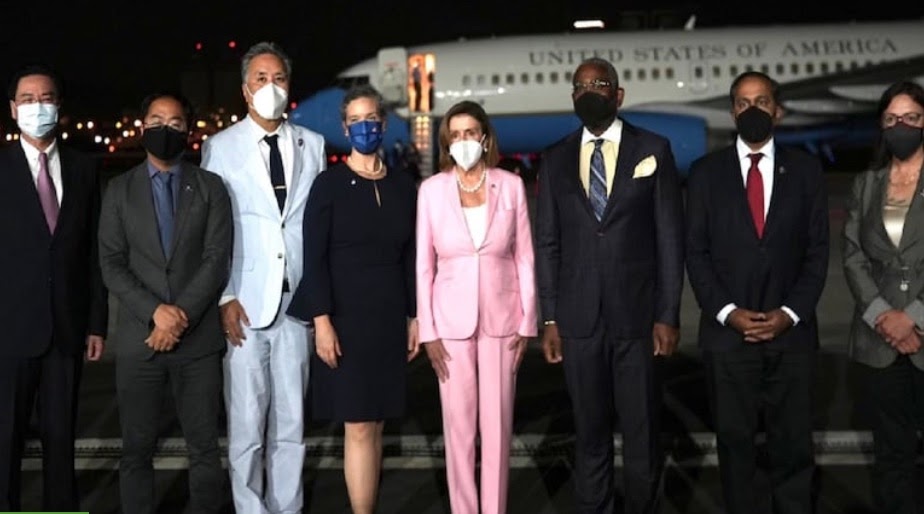
Hours after Pelosi’s visit, 27 Chinese fighter jets enter Taiwan’s air defense zone
By Vikas Gupta
Defence News of India, 4 Aug 22
Triggering a major escalation in tensions between the People’s Republic of China (PRC) and the United States (US), a senior US official – Speaker of the House of Representatives Nancy Pelosi – landed in Taipei, Taiwan on Tuesday, unaware Beijing’s furious threats that China would treat this as a violation of its sovereignty and respond with military force.
America has exercised caution in its relations with communist China, especially on the issue of Taiwan. Senior US officials avoided Taiwan, and only one US President, Dwight D Eisenhower, visited the island in 1960. The last senior US official to visit Taiwan was one of Pelosi’s predecessors in 1997 – Newt Gingrich, the Speaker of the House at that time. time.
In its strategic message, Beijing has consistently indicated that it views any threat to Taiwan, or any move toward independence from the Republic of China (ROC) government, as an existential threat to the PRC. Such a threat would be met by military force and, if necessary, by the use of nuclear weapons.
The PRC also announced live-fire military exercises encircling Taiwan, which the Taipei Defense Ministry said threatened major ports and urban areas on the island. In some places, Chinese operations will approach within 20 km of Taiwan’s coastline, according to coordinates shared by the PLA.
The 23 million inhabitants of Taiwan have lived for decades in the shadow of a possible invasion. Today, that threat has intensified under President Xi Jinping, China’s current and most assertive leader in a generation.
“If Pelosi insists on surrendering to Taiwan, China will take resolute and strong measures to defend its sovereignty and territorial integrity,” PRC Foreign Ministry spokesman Zhao Lijian warned Monday. “Those who play with fire will perish by it.”
In a phone call to his counterpart, Joe Biden, Chinese President Xi Jinping warned against “interference” in the island.
“One China” Policy
Over the years, Beijing’s intransigent diplomacy has compelled many countries, including the United States, to deal with Taiwan as a “one China”. This is the official position of the PRC, which maintains that there is only one sovereign state called China, with the PRC being its only legitimate government. The One China Principle “recognizes that all Chinese across the Taiwan Strait hold that there is only one China and Taiwan is one.”
The United States does not technically support Taiwan independence. Through diplomatic pressure, Beijing attempts to keep the ROC isolated on the world stage and opposes countries having official trade with Taipei.
Taiwan Relations Act, 1979
Beijing will never tolerate direct relations between the United States and Taiwan, as it views Taiwan as just a renegade province, awaiting reunification with the mainland. To address this sensitivity, President Jimmy Carter passed the Taiwan Relations Act in 1979, which set out provisions governing unofficial relations between Washington and Taipei.
The Taiwan Relations Act of 1979 is not a defense treaty. This does not guarantee US military intervention if the People’s Liberation Army (PLA) attacks Taiwan. However, it states that “the United States will make available to Taiwan such defense articles and defense services as are necessary to enable Taiwan to maintain sufficient self-defense capabilities.”
Taiwan’s defense forces are small but well-equipped and efficient. Its air force has more than 300 fighter jets, including F-16s and Mirage 2000s. The ROC Navy, which will be called upon to block the PRC’s amphibious landings, deploys four destroyers, 22 frigates, 13 corvettes and four submarines. Even so, PLA will enjoy a heavy numerical advantage.
Decisions about what weaponry the United States will supply to Taiwan must be determined in Washington by the president and Congress. The US policy of “strategic ambiguity” only deters Taiwan from a unilateral declaration of independence, while deterring the PRC from unilaterally unifying Taiwan with the PRC.
Taiwan: a turbulent history
Taiwan is an island off the east coast of China, to which Chinese nationalists (the Kuomintang or KMT), led by Chiang Kai-shek, retreated in 1949 after being defeated in an armed revolution by the Chinese Communist Party (CCP).
The CCP took control of the mainland, where it established an ideological communist state, the PRC. Meanwhile, the KMT established itself in Taiwan as the ROC, eventually evolving into a liberal democracy.
The United States initially recognized the government of Taiwan as the legitimate government of China. But after Washington and Beijing formally established diplomatic ties in 1979, US-Taiwanese relations entered a decades-long diplomatic vacuum.
Washington and Taipei have behaved like allies, but neither has an official embassy in the other’s capital. US presidents have long avoided interacting with their Taiwanese counterparts, even by phone, so as not to irritate Beijing.
Now Nancy Pelosi has succeeded in doing what several American presidents have been unable or unwilling to do. China, however, continues to claim Taiwan as its own territory and has repeatedly threatened to use military force to seize the island. US military forces are now preparing for the aftermath of Pelosi’s visit.






